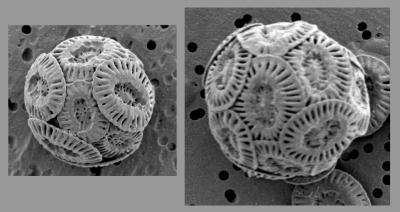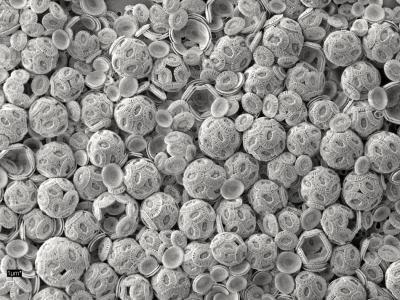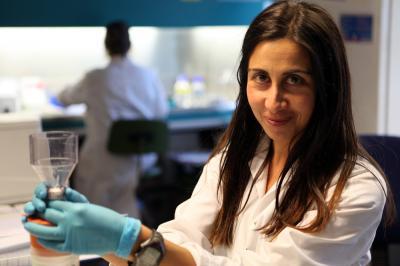(Santa Barbara, Calif.) –– Marine scientists have long understood the detrimental effect of fossil fuel emissions on marine ecosystems. But a group led by a UC Santa Barbara professor has found a point of resilience in a microscopic shelled plant with a massive environmental impact, which suggests the future of ocean life may not be so bleak.
As fossil fuel emissions increase, so does the amount of carbon dioxide oceans absorb and dissolve, lowering their pH levels. "As pH declines, there is this concern that marine species that have shells may start dissolving or may have more difficulty making calcium carbonate, the chalky substance that they use to build shells," said Debora Iglesias-Rodriguez, a professor in UCSB's Department of Ecology, Evolution and Marine Biology.
Iglesias-Rodriguez and postdoctoral researcher Bethan Jones, who is now at Rutgers University, led a large-scale study on the effects of ocean acidification on these tiny plants that can only be seen under the microscope. Their research, funded by the European Project on Ocean Acidification, is published in the journal PLoS ONE and breaks with traditional notions about the vitality of calcifiers, or creatures that make shells, in future ocean conditions.

This shows cells of the coccolithophore species Emiliania huxleyi strain NZEH under present-day, left, and future high, right, carbon dioxide conditions.
(Photo Credit: UCSB)
"The story years ago was that ocean acidification was going to be bad, really bad for calcifiers," said Iglesias-Rodriguez, whose team discovered that one species of the tiny single celled marine coccolithophore, Emiliania huxleyi, actually had bigger shells in high carbon dioxide seawater conditions. While the team acknowledges that calcification tends to decline with acidification, "we now know that there are variable responses in sea corals, in sea urchins, in all shelled organisms that we find in the sea."
These E. huxleyi are a large army of ocean-regulating shell producers that create oxygen as they process carbon by photosynthesis and fortify the ocean food chain. As one of the Earth's main vaults for environmentally harmful carbon emissions, their survival affects organisms inside and outside the marine system. However, as increasing levels of atmospheric carbon dioxide causes seawater to slide down the pH scale toward acidic levels, this environment could become less hospitable.
The UCSB study incorporated an approach known as shotgun proteomics to uncover how E. huxleyi's biochemistry could change in future high carbon dioxide conditions, which were set at four times the current levels for the study. This approach casts a wider investigative net that looks at all changes and influences in the environment as opposed to looking at individual processes like photosynthesis.
Shotgun proteomics examines the type, abundance, and alterations in proteins to understand how a cell's machinery is conditioned by ocean acidification. "There is no perfect approach," said Iglesias-Rodriguez. "They all have their caveats, but we think that this is a way of extracting a lot of information from this system."

This is a sample of an Emiliania huxleyi NZEH culture.
(Photo Credit: UCSB)
To mirror natural ocean conditions, the team used over half a ton of seawater to grow the E. huxleyi and bubbled in carbon dioxide to recreate both present day and high future carbon levels. It took more than six months for the team to grow enough plants to accumulate and analyze sufficient proteins.
The team found that E. huxleyi cells exposed to higher carbon dioxide conditions were larger and contained more shell than those grown in current conditions. However, they also found that these larger cells grow slower than those under current carbon dioxide conditions. Aside from slower growth, the higher carbon dioxide levels did not seem to affect the cells even at the biochemical level, as measured by the shotgun proteomic approach.
"The E. huxleyi increased the amount of calcite they had because they kept calcifying but slowed down division rates," said Iglesias-Rodriguez. "You get fewer cells but they look as healthy as those under current ocean conditions, so the shells are not simply dissolving away."
The team stresses that while representatives of this species seem to have biochemical mechanisms to tolerate even very high levels of carbon dioxide, slower growth could become problematic. If other species grow faster, E. huxleyi could be outnumbered in some areas.
"The cells in this experiment seemed to tolerate future ocean conditions," said Jones. "However, what will happen to this species in the future is still an open question. Perhaps the grow-slow outcome may end up being their downfall as other species could simply outgrow and replace them."

This shows UCSB Professor Debora Iglesias-Rodriguez in the lab.
(Photo Credit: UCSB)